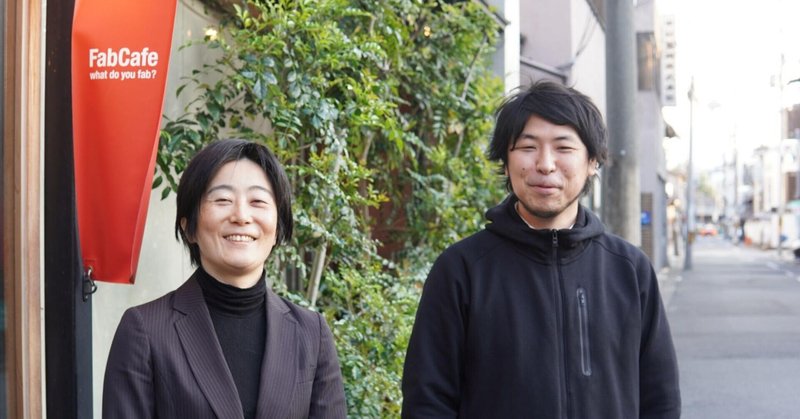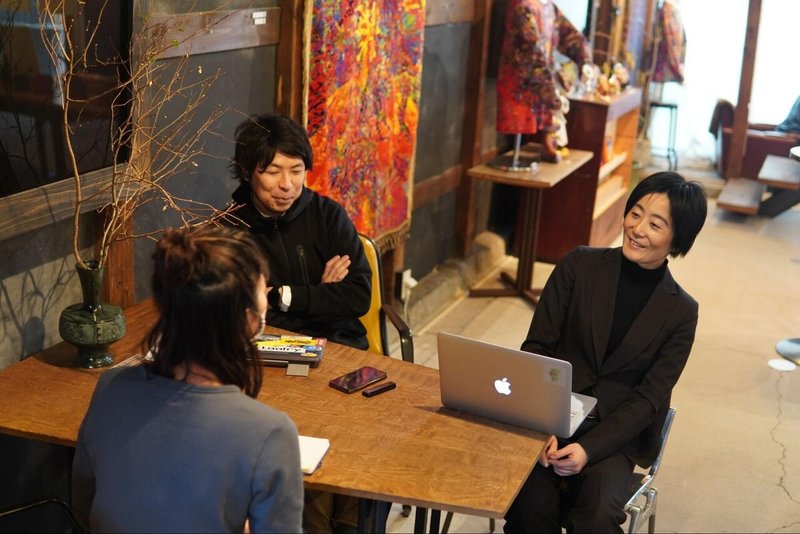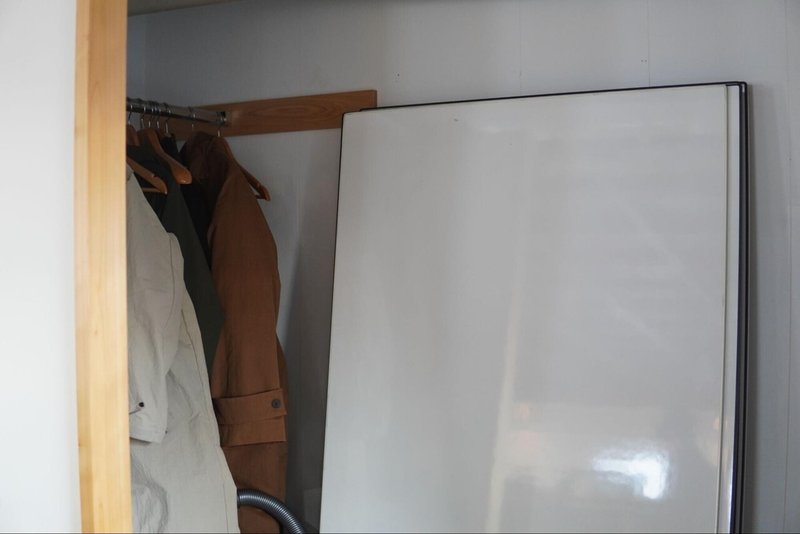
ideaboard® Series: Product Development Story #13_Partners | Loftwork Inc.
In December 2019, NKC Nakanishi Metal Works Co., Ltd. (NKC) launched their new whiteboard, “ideaboard®.” Revealed by the project members, this series records the story of how the ideaboard was brought to life, into ours.
Following the past eight articles covering our interview with Riku Nagasaki, developer of ideaboard and head of “KAIMEN” (the business design team reporting directly to the president at NKC), we now move on to the external partners with whom KAIMEN collaborated during ideaboard’s product development.
Here is our interview with Sawako Tanei and Kousuke Kinoshita from Loftwork Inc.

(Left) Sawako TANE
Loftwork MTRL Producer, Traveler
(Right) Kousuke KINOSHITA
Loftwork MTRL/FabCafe Kyoto Marketing & Produce
1.FabCafe Kyoto—a place where communities blossom
ーFirst, could you please tell us about your daily work?
Tane: In pursuit of making Fabcafe Kyoto a diverse place where people from all kinds of backgrounds can gather, I’m mainly working to connect those who visit, and search for those who would be an asset to our space and go hear their stories.
For instance, once I spoke to one of the guests working at Fabcafe, and I found that he is actually an anthropologist, telling me that his daily life mostly consisted of “digging stuff up.” Discovering these kinds of people living in their own fascinating world, I suggest how Fabcafe could be a great place for their community to blossom and invite them to our upcoming events and so on.
It’s been a difficult year for us to physically gather, but I feel that’s what had caused interesting things to emerge at the local level.
That’s why I got the title “Traveler” from the company, which for me is also the starting point of meeting a lot of people. Basically, it is a job of “discovering people’s strengths and pursuits, and connecting them with one another”.
Kinoshita: At Fabcafe Kyoto, it isn’t rare for someone you don’t know to suddenly start talking to you, or cut in on your conversation. People do get quite surprised by that.
I used to be the manager at Fabcafe Kyoto, but now I’m mainly helping manufacturers with their new business projects. I often play the role of being the person who bounces ideas off through considering the process of product development. I also organize workshops aiming at enhancing communication with our clients.

ーDo you remember when you first heard about the concept of the ideaboard?
Kinoshita: Besides being used as our office, Fabcafe is also used by people from outside our company for meetings, and so on. I remember first being asked about how whiteboards were being used in this specific setting.
Tane: We talked about how the whiteboards with legs would easily break, right?
Kinoshita: Right. Whiteboards with legs caused a lot of stress. Wobbly legs, broken casters, people tripping on them as they passed by. We talked about how we could possibly make them magnetic to make them stand on their own.
Tane: Magnets opened up many possibilities, such as dangling the boards from the ceiling, or using them as partitions. Above all, having the whiteboard without legs made things much easier.
I feel we humans are quite simple-minded, so when we find the “legs” to be the weakness, we’ll try to somehow come up with an innovative idea to strengthen the leg’s durability. However, Nagasaki-san didn’t think of it in that way. He decided to eliminate the legs and casters in the first place, which I found very impressive.
2. The pursuit of handiness and mobility
ーHow did you use the first prototype when it was delivered to the office?
Kinoshita: The first one was light and useful, but very difficult to stand up. First of all, we had difficulty connecting the boards with magnets. Even after succeeding in doing so, it would fall down when we tried to write on it. The magnetic structure was an interesting idea to make the board stand on its own after writing on it, but it didn’t work well when we tried to write on it while keeping it standing.
Even after teaching everyone how to connect the boards and “stand it up like a folding screen,” no one ended up doing so. They all eventually tilted the boards individually against the walls.
So I guess the feedback I gave was that the users didn’t prioritize the “self-standing” aspect of the board. All you needed was a wall to tilt it against, and there just didn’t seem to be that many occasions where it was essential to use the boards by connecting them and standing them up. This realization was something we couldn’t have known without actually using it ourselves.
ーTrying it out yourselves, what aspect of the ideaboard did everyone at Loftwork Inc. most resonate with?
Tane: We tend to move around a lot, so the idea of a portable whiteboard really hit the spot. Before, when we were still using whiteboards with legs, we struggled to carry them down from the 3rd to 1st floor, and usually ended up figuring out how to manage things without moving them. But now, those stakes have been lowered, and anyone can carry 2-3 boards in one go.
Kinoshita: Also, the fact that we can stack them up and store them in one place is a great advantage. I guess we could fit 20 ideaboards in the space equal to what we would need to store 3 whiteboards with legs.

We store them together and pull them out when needed. Since the ideaboard is something used during the process of quickly shaping ideas, this provisional and mobile aspect goes well with its concept.
3. Processing ideas—using your mind and body, language, and five senses
ーOnline meetings and workshops have become extremely popular through the outbreak of COVID‑19. How do you feel about brainstorming ideas online?
Kinoshita: I’ve become accustomed to using the online whiteboard service “miro.” In addition to its effectiveness in sharing ideas, I value how it frees us from any physical limits concerning space. We don’t have to deal with the issue of struggling to make space in order to paste additional things onto the board. To be honest, I feel more and more open to the idea of shifting everything online.
However, when I’m thinking inside my head and visualizing something that can’t be translated into words, like a diagram, I feel I need something that is physically real to output my thoughts.
Also, when trying to draw something like a map, the size or shape of one’s gestures may become crucial when explaining it to someone else. I feel that the body language used when one is writing down the letters or graphs can cause a huge difference in how the idea is communicated to others.

Tane: Since you concentrate hard on what’s happening on the screen in front of you, packing your schedule with online workshops can really tire you out. I realized that with workshops offline, you’re naturally taking scheduled breaks, drinking coffee, chatting with colleagues which all contribute to balancing out the pace and flow you work in.
Actually, I’m quite the analog type, and ten to write things down on paper. For me, the initial idea only comes alive on paper, so I try hard to put all my fuzzy thoughts into words and visualize ideas.
Having verbalized a thought means that you’ve once processed it. The limit of one’s vocabulary may hinder what one aims to express, and the aspect of the thought that was left non-verbalized will be omitted, not communicated. Therefore, putting effort into verbalizing your thoughts is important, but recognizing the fact that there exists a great part of the thought that hasn’t been verbalized is essential. It goes the same for brainstorming—you can create a neat-looking diagram that compiles the ideas, but actually, the process of creating it may be what is more important.

Kinoshita: I think this is exactly what happens when we gather for a workshop in the real space, where questions are asked, new insights are made, and then we come up with something else. I do think that actually moving our hands, expressing our thoughts through not only visual or verbal but also our five senses, and working together in a physical space contributes to enhancing the quality of communication.
ーFinally, please tell us your thoughts when looking back on the project of the ideaboard.
Kinoshita: Considering that Fabcafe Kyoto was the so-called “co-working space” at the time, KAIMEN could have come to us proposing that we monitor-test the product or spread information about it. However, that wasn’t the case. They knew we were in need of something like it, and had us actually use the product until we could identify what was necessary/unnecessary. Rather than coming to ask us for a favor, they brought us into “collusion”, and we were able to co-create the product’s value. We ourselves at Fabcafe Kyoto emphasize the value of “space” “community” and “the process of practice,” so we were grateful to be involved.
Tane: I agree. Nagasaki-san’s way of Involving those around him and creating what is needed according to its necessity was impressive. He resembles Edison—though his appearance reminds me of Snufkin, lol.

To be continued in “ideaboard Series: Product Development Story #14"
(Interview, translation, and photos by Mone Nishihama and Kyoko Yukioka, NINI Co., Ltd.)
▼Click below to see the original Japanese version / 原文はこちら
この記事が気に入ったらサポートをしてみませんか?
